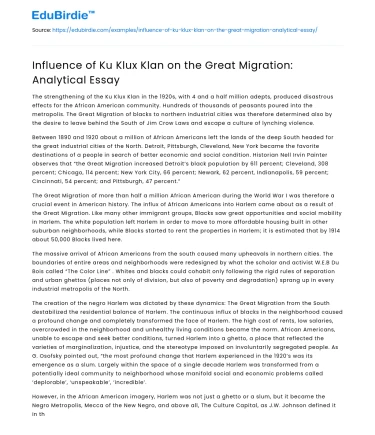The strengthening of the Ku Klux Klan in the 1920s, with 4 and a half million adepts, produced disastrous effects for the African American community. Hundreds of thousands of peasants poured into the metropolis. The Great Migration of blacks to northern industrial cities was therefore determined also by the desire to leave behind the South of Jim Crow Laws and escape a culture of lynching violence.
Between 1890 and 1920 about a million of African Americans left the lands of the deep South headed for the great industrial cities of the North. Detroit, Pittsburgh, Cleveland, New York became the favorite destinations of a people in search of better economic and social condition. Historian Nell Irvin Painter observes that “the Great Migration increased Detroit’s black population by 611 percent; Cleveland, 308 percent; Chicago, 114 percent; New York City, 66 percent; Newark, 62 percent, Indianapolis, 59 percent; Cincinnati, 54 percent; and Pittsburgh, 47 percent.”
Save your time!
We can take care of your essay
- Proper editing and formatting
- Free revision, title page, and bibliography
- Flexible prices and money-back guarantee
The Great Migration of more than half a million African American during the World War I was therefore a crucial event in American history. The influx of African Americans into Harlem came about as a result of the Great Migration. Like many other immigrant groups, Blacks saw great opportunities and social mobility in Harlem. The white population left Harlem in order to move to more affordable housing built in other suburban neighborhoods, while Blacks started to rent the properties in Harlem; it is estimated that by 1914 about 50,000 Blacks lived here.
The massive arrival of African Americans from the south caused many upheavals in northern cities. The boundaries of entire areas and neighborhoods were redesigned by what the scholar and activist W.E.B Du Bois called “The Color Line” . Whites and blacks could cohabit only following the rigid rules of separation and urban ghettos (places not only of division, but also of poverty and degradation) sprang up in every industrial metropolis of the North.
The creation of the negro Harlem was dictated by these dynamics: The Great Migration from the South destabilized the residential balance of Harlem. The continuous influx of blacks in the neighborhood caused a profound change and completely transformed the face of Harlem. The high cost of rents, low salaries, overcrowded in the neighborhood and unhealthy living conditions became the norm. African Americans, unable to escape and seek better conditions, turned Harlem into a ghetto, a place that reflected the varieties of marginalization, injustice, and the stereotype imposed on involuntarily segregated people. As G. Osofsky pointed out, “the most profound change that Harlem experienced in the 1920’s was its emergence as a slum. Largely within the space of a single decade Harlem was transformed from a potentially ideal community to neighborhood whose manifold social and economic problems called ‘deplorable’, ‘unspeakable’, ‘incredible’.
However, in the African American imagery, Harlem was not just a ghetto or a slum, but it became the Negro Metropolis, Mecca of the New Negro, and above all, The Culture Capital, as J.W. Johnson defined it in the essay published in the anthology The New Negro: an interpretation (1925); this role derived mainly from the fact that Harlem was considered a city within a city, a space with its own history, with its own contradictions.
The prestige of Harlem in the eyes of the African American community was also due to its enviable position and its architectural and urban characteristics. If the ghettos of other northern cities were stigmatized as Niggertowns, Nigger Rows, Smoke Towns or Bronzevilles and represented places on the margins, worlds in their own, isolated from the social and cultural life of the city, Harlem, as J. W. Johnson points out, in this context was a real exception:
In the wake-up of New York, Harlem is not merely a Negro colony or community, it is a city within a city, the greatest Negro city in the world. It is not a slum or a fringe, it is located in the heart of Manhattan and occupies one of the most beautiful and healthful sections of the city. It is not a “quarter” of dilapidated tenements but is made up of new-law apartments and handsome dwellings, with well-paved and well-lighted streets.
In the evolution from White to Negro, Harlem managed to preserve the typical appearance of a residential neighborhood destined, originally, to permanently host the rich exponents of the New York upper and middle class.
The Great Migration from the South reached its peak during the Harlem Renaissance causing a further increase of the black population in the city. In a few years Harlem established itself both as a residence for workers of the lower classes, and as an elegant entertainment center, that attracted the upper-middle classes of the African American and Euro-American bourgeoisie. Harlem’s claim as a cultural capital and gathering center for influences and moods around the world produced changes in both living habits and goals that seemed to transform Northern urban societies, regardless of ethnicity, into communities populated by new types of people.






 Stuck on your essay?
Stuck on your essay?

